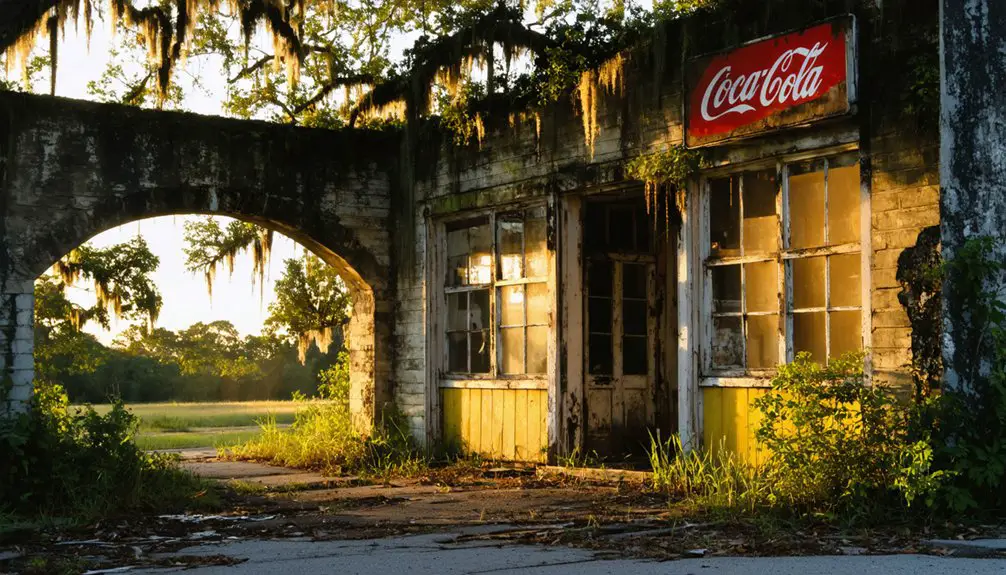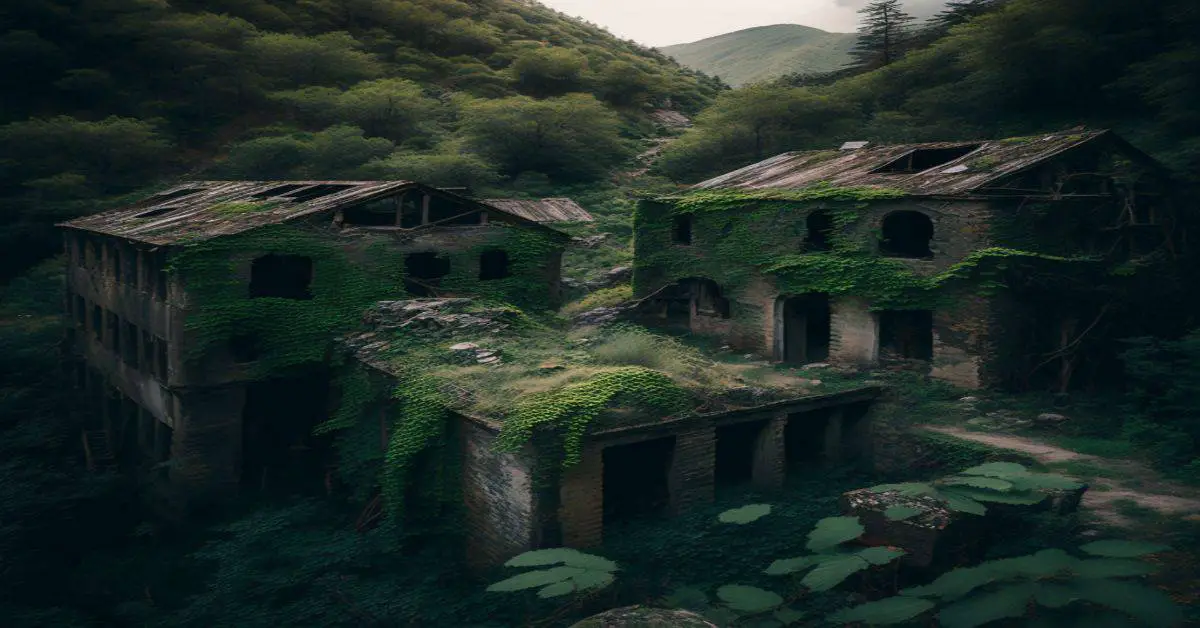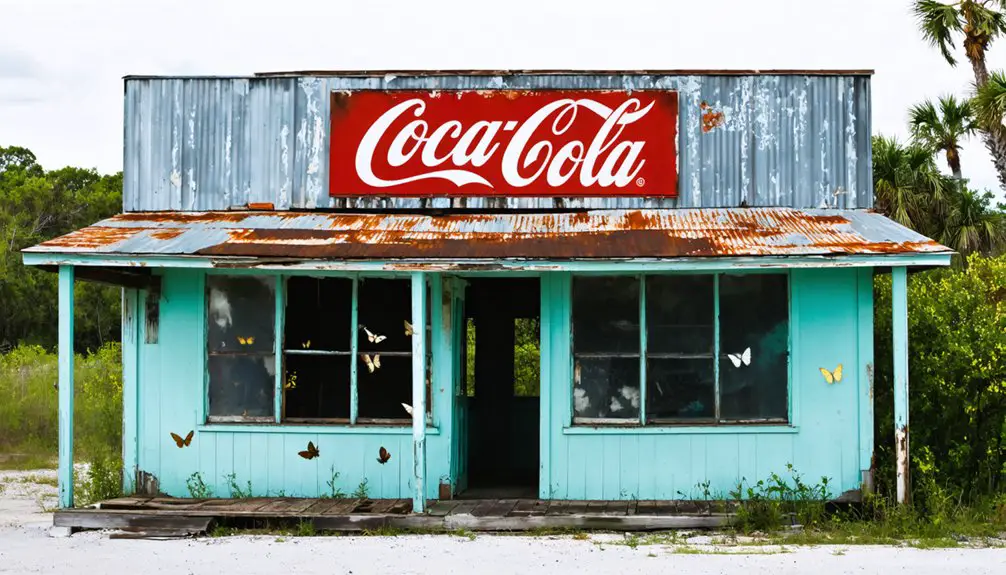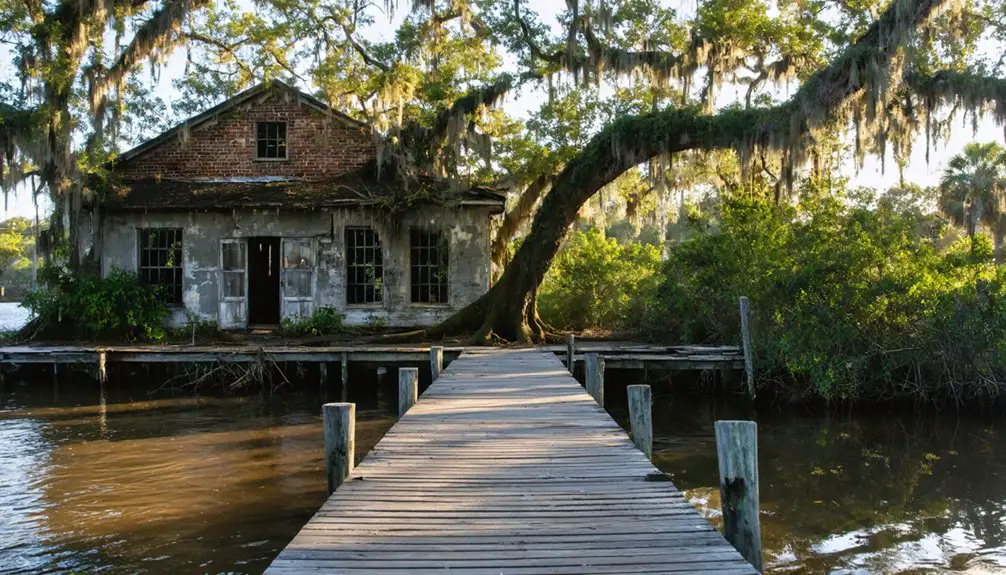You’ll find Florida’s ghost towns scattered across the state, from military outposts established in 1842 to ambitious developments like Aladdin City from 1925. These abandoned settlements tell stories of natural disasters, economic busts, and military deactivations, with Fort Dade’s once-bustling community of 600 residents now reduced to crumbling brick roads and artillery batteries. Today, you can explore these haunting remnants, from Fort Jefferson’s massive masonry to Oriole’s historic cemetery, where Florida’s forgotten chapters await your discovery.
Key Takeaways
- Fort Dade’s abandoned military installations feature eerie remnants like deteriorating brick roads and empty artillery batteries on Egmont Key.
- The Oriole Cemetery, Hernando County’s third oldest, offers haunting glimpses into early settler life and historic grave markers.
- Aladdin City’s failed 1925 development stands as a ghostly reminder of Florida’s dramatic land bust period.
- Fort Jefferson’s massive masonry structure remains hauntingly isolated as America’s largest brick fortification in the Caribbean.
- Ghost towns like Jensen Beach showcase storm-damaged buildings and boarded-up stores, reflecting Florida’s vulnerability to natural disasters.
Lost Frontiers: Florida’s Most Mysterious Ghost Towns
While Florida’s modern cities bustle with life, scattered across the state lie the haunting remains of once-thriving communities that time has forgotten.
You’ll find the mysterious remnants of Aladdin City, a grandiose 1925 development that collapsed during Florida’s infamous land bust, leaving behind only ghostly street grids and a handful of abandoned structures.
Further north, you can explore what’s left of Oriole, a small farming settlement where roughly 100 pioneers carved out their lives until nature struck back. The devastating Great Freezes of 1894-1895 destroyed their crops, while an influenza outbreak dealt the final blow. Many ghost towns have been transformed into historical parks where visitors can explore preserved structures and artifacts.
In Monroe County, visitors can discover Fort Jefferson, the largest masonry structure in the Americas, now standing as a silent sentinel of Florida’s military past.
Today, only the Oriole Cemetery, the third oldest in Hernando County, stands as a silent witness to these hardy settlers’ dreams and struggles.
The Rise and Fall of Fort Dade: An Island’s Untold Story
If you’d visited Fort Dade during its heyday around 1900, you’d have found a bustling military community complete with bowling alleys, tennis courts, and a movie theater serving up to 600 residents during World War I.
The fort’s strategic importance diminished rapidly after the war as advances in naval warfare made fixed coastal defenses obsolete, leading to its deactivation in 1923.
The fort’s early history included serving as a base for the Union blockading fleet that conducted operations against Confederate forces in Tampa Bay during the Civil War.
Today, you can walk the weathered brick paths of Egmont Key State Park, where Fort Dade’s remnants tell the story of a once-thriving island outpost that protected Tampa Bay for a quarter century.
The island’s modern role has shifted dramatically, now serving as a wildlife refuge where endangered species like box turtles and shorebirds find sanctuary.
Military Life and Leisure
Although military life often conjures images of strict discipline and combat readiness, Fort Dade offered a unique blend of military precision and small-town comfort during its heyday.
You’d find more than 300 residents, including soldiers and civilians, enjoying modern amenities like electricity and telephones – luxuries for that era. Military camaraderie flourished as troops gathered at the bowling alley, movie theater, and tennis courts after their duties. The fort’s construction was completed in 1906, creating a self-sufficient military community.
Despite its remote island location, you could experience a full community life with access to medical care at the hospital and essential services throughout the brick-paved streets. The fort’s strategic position made it an integral part of the Tampa Bay defense system during wartime operations.
The Coast Artillery’s presence of 130 personnel by 1920 created a diverse social atmosphere where African American and white service members, both men and women, contributed to this unique military town‘s character.
Abandonment After World War
As the guns of World War I fell silent in 1918, Fort Dade’s strategic importance began to wane rapidly.
You’d have witnessed a dramatic post-war shift as the fort’s population plummeted from its wartime peak of 600 to just 294 soldiers by 1920, mostly Coast Artillery personnel maintaining the aging facilities.
The military deactivation came swiftly in 1923, leaving behind a ghost town of abandoned barracks, a defunct power plant, and overgrown artillery batteries. The fort’s red brick streets remain as one of the few intact remnants of its military past.
You can still find traces of this once-bustling military community, now reclaimed by nature.
The Tampa Bay Pilots Association took over operations in 1926, transforming the island’s purpose from military defense to maritime navigation.
Where soldiers once trained and families lived, only ruins remain, silent witnesses to Fort Dade’s forgotten chapter in Florida’s military history.
Exploring Today’s Island Ruins
When you visit Egmont Key today, the crumbling remains of Fort Dade tell a haunting story of military innovation and inevitable decline.
As you explore this island’s haunted history, you’ll discover weathered ruins slowly surrendering to nature’s relentless assault. Built in 1898 for protection during the Spanish-American War, the fort represented a crucial defense point for Florida’s coast.
Your island exploration reveals:
- Partially submerged ammunition bunkers and earthworks, victims of persistent coastal erosion
- Remnants of brick roads that once connected the lighthouse, pilot station, and military structures
- Shells of former barracks, a hospital, and recreational facilities including a movie theater
- Concrete artillery batteries that once protected Tampa Bay’s strategic entrance
What was once a thriving military community of 600 people now stands as a silent reflection of time’s passage, where wind-swept ruins and shifting sands preserve memories of Florida’s coastal defense heritage.
Natural Springs and Abandoned Dreams: Hampton Springs Hotel
Hidden among Florida’s forgotten landmarks, the Hampton Springs Hotel emerged from a fortuitous discovery by early settler Joe Hamilton, who learned of healing sulfur springs from Native Americans in the area.
The Hampton brothers purchased the land in 1879 for $400, launching their vision of a therapeutic resort destination. By 1908, you’d have found a magnificent two-story hotel with 70 rooms, later expanding to include luxurious amenities like elaborate gardens, a casino, and one of the region’s first golf courses. A successful bottling plant operation distributed the spring’s healing waters to customers across the nation. During World War II, the property served as military barracks for service personnel.
Railroad magnate J.W. Oglesby’s involvement in 1915 transformed accessibility, helping the resort reach its peak in the 1920s.
Tragically, fire consumed the hotel in 1954. Today, you’ll find haunting ruins, including the spring-fed pool where sulfur waters still flow, surrounded by nature trails and picnic areas.
Military Outposts to Empty Graves: Fort Drum’s Legacy
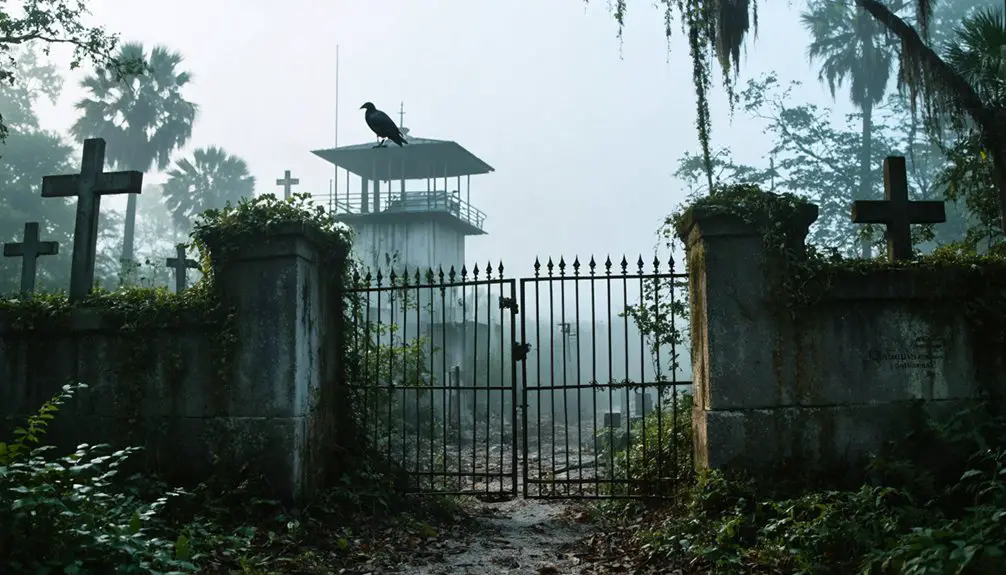
Deep in central Florida’s heartland, Fort Drum stands as a symbol of America’s military strategy during the Second Seminole War.
You’ll discover Fort Drum’s transformation from a strategic military crossroads to a ghostly reminder of Florida’s frontier past.
- Built after 1842 where two significant military roads intersected, controlling routes between Fort Bassinger, Fort Vinton, Fort Kissimmee, and Fort Jupiter.
- Settlers transformed the abandoned outpost into a thriving cattle community by the 1870s.
- The Florida East Coast Railroad’s 1914 Kissimmee Valley Extension brought new life through the train depot.
- Today, the military legacy lives on through empty graves and abandoned structures.
What you’ll find now is a haunting slice of history where this once-bustling settlement has faded into Florida’s landscape, leaving behind echoes of both military might and pioneer spirit.
Why These Towns Vanished: From Prosperity to Abandonment
Throughout Florida’s history, the rise and fall of ghost towns followed predictable patterns of boom-and-bust cycles that you can still trace today.
You’ll find these abandoned settlements were often victims of economic decline triggered by their dependency on single industries like mining, citrus farming, or railroads. When these enterprises failed, entire communities collapsed.
Natural disasters dealt devastating blows to these vulnerable towns. Hurricanes, floods, and events like the “Big Freeze” of 1894-1895 destroyed property and crops, forcing residents to flee.
Many communities couldn’t recover from the double impact of environmental catastrophes and financial hardship. The rise of automobile travel dealt another blow, as new highways bypassed once-thriving railroad stops.
Agricultural mechanization and failed land speculation schemes sealed the fate of other towns, leaving behind empty streets where prosperity once reigned.
Visiting Florida’s Ghost Towns: What Remains Today
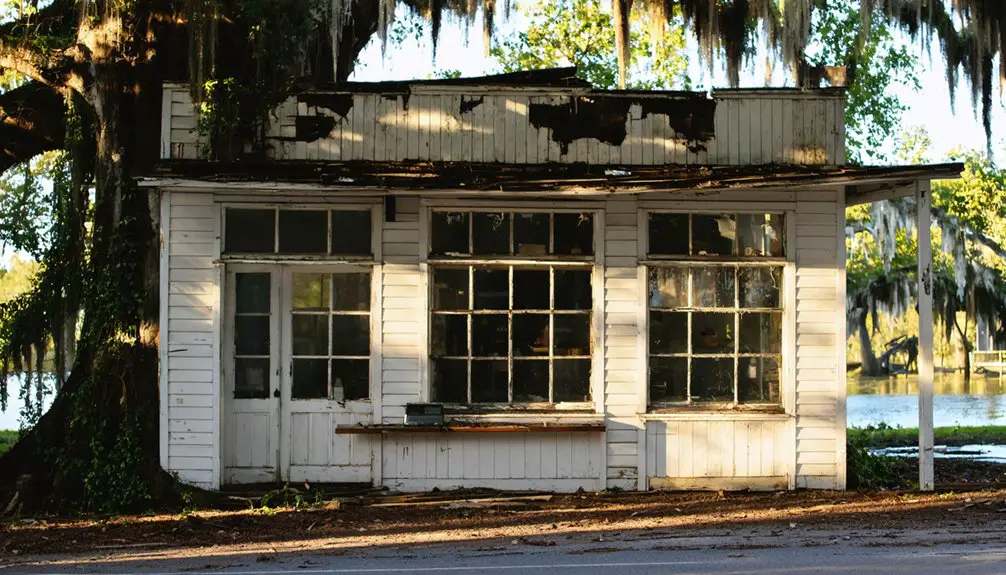
When you venture into Florida’s ghost towns today, you’ll encounter a diverse spectrum of abandonment, from crumbling military installations to storm-ravaged residential complexes.
Your ghost town exploration reveals layers of the Sunshine State’s forgotten past, where nature steadily reclaims once-bustling communities.
- Fort Dade’s deteriorating brick roads and military batteries on Egmont Key offer a glimpse into Tampa Bay’s wartime history.
- Jensen Beach’s boarded-up buildings and storm-damaged stores stand as evidence to coastal development conflicts.
- Hurricane Ian’s devastating impact left an Orlando apartment complex frozen in time, showcasing urban decay.
- Rising insurance costs and market instability create modern ghost towns, with some neighborhoods tripling in vacant homes.
Your visit to these sites requires careful planning, as many remain accessible only by boat or through restricted areas.
Frequently Asked Questions
Are There Any Reported Paranormal Activities in Florida’s Ghost Towns?
You’ll find numerous haunted legends across Florida’s ghost towns, from John Mikler’s spirit in Slavia to ghost sightings at Fort Dade, where phantom gunfire echoes and an unmanned lighthouse mysteriously activates.
Can Visitors Take Artifacts or Souvenirs From Ghost Town Sites?
You can’t legally remove artifacts or souvenirs from ghost towns – it’s strictly prohibited by artifact regulations and souvenir ethics. You’ll face penalties for disturbing these protected historical sites.
Which Ghost Towns Are Accessible Without Special Permits or Guides?
You’ll find freely accessible ghost town history at Egmont Key, Aurytown, Otter Creek, and Indian Key. These sites let you explore abandoned structures without permits, though you must stick to public areas.
Do Any Ghost Towns Still Have Complete, Standing Buildings?
With only six complete abandoned structures remaining, you’ll find Stiltsville’s historic buildings standing over Biscayne Bay. It’s Florida’s best-preserved ghost town, though you’ll need a permit to visit these historical treasures.
What Safety Precautions Should Explorers Take When Visiting Ghost Towns?
Pack explorer gear including flashlights, N95 masks, and first aid kits. Follow safety guidelines by marking your path, avoiding unstable structures, and telling others your plans before exploring abandoned sites.
References
- https://www.florida-backroads-travel.com/florida-ghost-towns.html
- https://www.ghosttowns.com/states/fl/fl.html
- https://en.wikipedia.org/wiki/List_of_ghost_towns_in_Florida
- https://www.timeout.com/florida/florida-ghost-towns
- https://www.youtube.com/watch?v=bNjqcQ5SMwg
- https://freepages.history.rootsweb.com/~gtusa/usa/fl.htm
- https://floridatrailblazer.com/category/ghost-towns/page/2/
- https://www.freakyfoottours.com/us/florida/
- https://floridaseminoletourism.com/a-dark-history-at-egmont-key/
- https://www.legendsofamerica.com/fort-dade-egmont-key/
